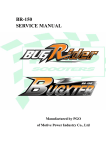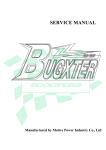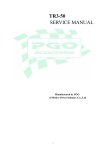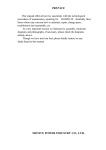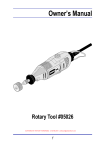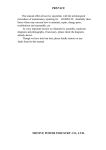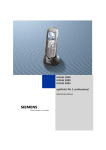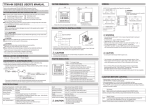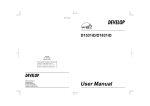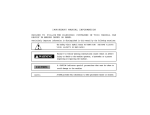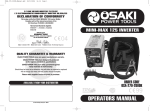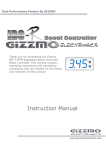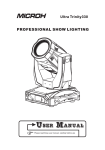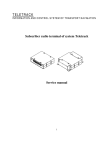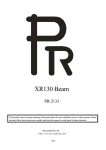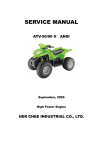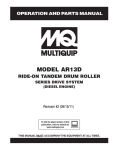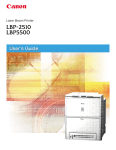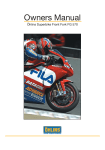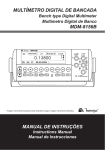Download (G-Max) Service Manual
Transcript
PREFACE This manual provides every service specialist with professional techniques of maintenance and repairing for G-MAX (ALLORO). It provides a detailed guide for those who may concern with how to maintain, repair, reassemble, and change parts of their scooters. This manual includes 3 kinds of engine displacement: G-MAX 50 (ALLORO 50): abbreviated as “M2-50” is 2 stroke engine (2T), 50cc displacement. G-MAX 125 (ALLORO 125): abbreviated as “M2-125” is 4 stroke engine (4T), 125cc displacement. G-MAX 150 (ALLORO 150): abbreviated as “M2-150” is 4 stroke engine (4T), 150cc displacement. At every section, we illstrate each important point by assembling procedures, explosive diagrams and photographs. Although we have tried our best to make this manual as perfect as possible, please kindly inform us if any fault needs to be corrected in this manual. Thank you for purchasing our PGO scooters. FACTORY Motive Power Industry Co.,Ltd. CONTENTS .The specification of G-MAX (ALLORO) .Service information (1)The operation notice (2)Locking torque value (3)Lubrication instruction (4)Periodical maintenance table (5)Troubleshooting .Checking and adjustment (1)Regular checking table (2)Battery (3)Cleaning air cleaner (4)The final reduction mechanism oil (5)Spark plug (6)Compression pressure measurement (7)Ignition timing (8)Throttle cables adjustment (9)Idle adjustment (10)Front brake adjustment (11)Rear brake adjustment (12)Tire .Dismantling, maintaining, repairing and assembling operation (1)Plastic parts (2)G-MAX 50 Engine dismantling A. Lubrication system B. Drive pulley, starter, clutch C. Cylinder and piston D. AC generator E. Final transmission mechanism F. Crankcase, crank shaft G. Carburetor, reed valve (3)G-MAX 125/150 Engine dismantling A. Lubrication system B. Drive pulley, starter, clutch C. Cylinder and piston D. AC generator E. Final transmission mechanism F. Crankcase, crank shaft Page G. Carburetor (4)Engine & chassis suspension (5)Steering column, front wheel, front brake comp, front fork (6)Rear wheel, rear brake, rear damper (7)Fuel tank, oil tank (8)Reverse Differential gear comp .Electric equipment (1)Troubleshooting (2)Battery (3)Recharge system (4)Ignition system (5)Starting system (6)Switch operation (7)Wiring diagram 1.1 G-MAX 50 730 mm HEIGHT 1170 mm AXLE DISTANCE 1365 mm FRONT 47 KG REAR 58 KG TOTAL 105 KG PASSENGER 2 (110KG) FRONT 82 KG REAR 133 KG TOTAL 215 KG TOP SPEED 60 km/hr TOTAL 45 km/l CONSUMPTION ON FRONT TELESCOPE REAR SWING PRIMARY DIRECT 2ND 52/13*44/13 CLUTCH CENTRIGUAL SHIFTING V-BELT C.V.T FRONT 120/70-12 REAR 130/70-12 FRONT DISK REAR DRUM SPEEDOMETER 80 km/hr HEAD(HI LO) 12V-35W/35W REAR 12V-5W BRAKE 12V-21W SIGNAL 12V-10W*4 19° ENGINE MODEL P2 HORN DC 12V FUEL 92 UNLEADED SILENCER DIFFUSER STROKE 2T AIR FORCED CYLINDE GRADIENT EXHAUS WEIGHT PERFORMAN ENGINE FUEL ENSI WIDTH KE 1855 mm SUSP LENGTH TRANSMISSI M2-50D STEEL PIPE TIRE MODEL FRAME BRA PGO LIGGHT BRAND GROSS DIMENSION SPECIFICATION PARTICLE BELOW 15 % CO BELOW 4.5% HC BELOW 7000 ppm BORE φ40.0 mm STROKE 39.2 mm CYLINDER SINGLE EXHAUST LAYOUT RIGHT DISPLACEMENT 49 cc LUBRICATE SEPARATE PUMP C.R. 6.8 1 FUEL TANK 7.5 L MAX H..P. 3.5kw/7000rpm MAX TORQUE 5.0N-M/6500rpm LAYOUR HORIZONAL IGNITION CDI STARTING ELECTRIC & KICK 1.2 G-MAX 125 730 mm HEIGHT 1170 mm AXLE DISTANCE 1365 mm FRONT 54 KG REAR 76 KG TOTAL 130 KG PASSENGER 2 (110KG) FRONT 94 KG REAR 146 KG TOTAL 230 KG TOP SPEED 84 km/hr TOTAL 40 km/l CONSUMPTION ON FRONT TELESCOPE REAR SWING PRIMARY DIRECT 2ND 43/14*42/13 CLUTCH CENTRIGUAL SHIFTING V-BELT C.V.T FRONT 120/70-13 REAR 130/70-13 FRONT DISK REAR DISK SPEEDOMETER 140 km/hr HEAD(HI LO) 12V-35W/35W REAR 12V-5W BRAKE 12V-21W SIGNAL 12V-10W*4 21° ENGINE MODEL C1M HORN DC 12V FUEL 92 UNLEADED SILENCER DIFFUSER STROKE 4T AIR FORCED CYLINDE GRADIENT EXHAUS WEIGHT PERFORMAN ENGINE FUEL ENSI WIDTH KE 1855 mm SUSP LENGTH TRANSMISSI M2-50D STEEL PIPE TIRE MODEL FRAME BRA PGO LIGGHT BRAND GROSS DIMENSION SPECIFICATION PARTICLE BELOW 15 % CO BELOW 4.5% HC BELOW 7000 ppm BORE φ51.5 mm STROKE 60.0 mm CYLINDER SINGLE EXHAUST LAYOUT RIGHT DISPLACEMENT 124.9 cc LUBRICATE SEPARATE PUMP C.R. 9.2 1 MAX H..P. 6.5kw/7500rpm MAX TORQUE 9.1N-M/6250rpm LAYOUR HORIZONAL IGNITION CDI STARTING ELECTRIC & KICK & SPLASH FUEL TANK 7.5 L 1.3 G-MAX 150 730 mm HEIGHT 1170 mm AXLE DISTANCE 1365 mm FRONT 55 KG REAR 77 KG TOTAL 132 KG PASSENGER 2 (110KG) FRONT 95 KG REAR 147 KG TOTAL 242 KG TOP SPEED 87 km/hr TOTAL 40 km/l CONSUMPTION ON FRONT TELESCOPE REAR SWING PRIMARY DIRECT 2ND 42/15*42/13 CLUTCH CENTRIGUAL SHIFTING V-BELT C.V.T FRONT 120/70-13 REAR 130/70-13 FRONT DISK REAR DISK SPEEDOMETER 1400 km/hr HEAD(HI LO) 12V-35W/35W REAR 12V-5W BRAKE 12V-21W SIGNAL 12V-10W*4 24° ENGINE MODEL C5M HORN DC 12V FUEL 92 UNLEADED SILENCER DIFFUSER STROKE 4T AIR FORCED CYLINDE GRADIENT EXHAUS WEIGHT PERFORMAN ENGINE FUEL ENSI WIDTH KE 1855 mm SUSP LENGTH TRANSMISSI M2-150 STEEL PIPE TIRE MODEL FRAME BRA PGO LIGGHT BRAND GROSS DIMENSION SPECIFICATION PARTICLE BELOW 15 % CO BELOW 4.5% HC BELOW 7000 ppm BORE φ57.0 mm STROKE 57.8 mm CYLINDER SINGLE EXHAUST LAYOUT RIGHT DISPLACEMENT 147.5 cc LUBRICATE SEPARATE PUMP C.R. 9.4 1 MAX H..P. 7.7kw/7250rpm MAX TORQUE 10.6N-M/6250rpm LAYOUR HORIZONAL IGNITION CDI STARTING ELECTRIC & KICK & SPLASH FUEL TANK 7.5 L .Service information (1)The operation notice (2)Locking torque value 1.For engine 2. For chassis 3. Others (3) Lubrication instruction a.For engine b. For chassis c. Wheel bearing (4)Wiring diagram (5)Troubleshooting 1.Difficult starting or starting 2.Weak acceleration 3.Engine running not smoothly (low speed) 4.Engine running not smoothly(high speed) 5.Clutch, drive & driven pulley 6.Handlebar steering was astray when running 7.Front and rear damper not balanced 8.Brake disorder 9.Oil indicator malfunction 10. Fuel indicator malfunction 11. Starting motor malfunction 12.No sparking 13.Charging abnormal (1)The operation notice 1.For parts like the gasket, o-ring, clips and circlets, please change a new part whenever re-assembled. 2.When trying to tighten screws or nuts, please lock tightly according to each recommended locking torque and in the sequence of the ”X” pattern. 3.Please use PGO or PGO recommended parts. 4.After dismantling, please clean all parts involved or used for checking and grease all contact surfaces when reassembling. 5.Use grease recommended by P.G.O. 6.When removing the battery, please disconnect the negative pole(-) first. However, please connect the positive pole(+) first when assembling. 7.Before installing a new fuse, please be sure that the specification is correct. 8.After reassembling, please re-confirm that all connecting point, locking parts, circuits, polar characteristics are functioning well before selling out. (2) Locking Torque Value: 1. 2T Engine (50CC) No 1 2 3 4 5 6 7 8 9 10 11 12 13 14 15 16 Locking Remarks Dia (mm) torque kg-m Cylinder head 7 1.0~1.4 When the engine is cold Flywheel outer 10 3.2~4.0 Rear brake lever 6 1.0~1.2 Driving pulley 10 3.2~4.0 Clutch outer 10 3.5~4.0 Right crankcase 6 1.0~1.2 Drive gear box cover 6 1.0~1.2 Left crankcase 6 1.0~1.2 Draining and filler bolt 8 1.8 When the engine is cold Inlet pipe 6 1.0~1.2 Flywheel magneto stator 6 1.0~1.2 Cooling fan 6 1.0~1.2 Muffler nut on cylinder 6 1.0~1.2 When the engine is head cold Starting motor 6 1.0~1.4 When the engine is cold Bracket between eng. and 6 1.0~1.2 Rubber pad of central stand Spark plug 14 2.5~3.0 Locking location Thread 17 Fan cover 6 1.0~1.2 18 Fixed plate, drive clutch 6 1.0~1.4 19 Nut of rear wheel axle 14 11~13 20 Kick starter 6 1.0~1.2 U TYPE NUT 2. 4T Engine (125/150 CC) NO Locking location Q’ty Thread dia. Locking torque (mm) (kg-m) 5 0.7~0.8 6 0.7~1.0 6 0.9~1.1 1 Fixing nut (Tappet screw nut) 2 Nut of oil pump sprocket 3 Cylinder head bolt A (intake) 2 1 2 4 Guiding pin bolt, chain extensioner 1 6 0.4~0.6 5 Screw, chain extensioner 2 6 0.9~1.1 6 Cylinder head bolt B (Exhaust) 2 8 2.0~2.3 7 Flange nut, cam shaft holder 4 8 2.0~2.3 8 Gear oil drain bolt 1 8 1.7~2.0 9 Spark plug 1 10 1.2~1.3 10 Nut of fly wheel 1 12 5.0~6.0 11 Fixing nut, clutch outer 1 12 5.0~6.0 12 Nut, driving plate 1 12 5.0~6.0 13 Bolt of engine oil drain 1 12 2.5~3.0 nd 14 Bolt of 2 oil filter 1 12 0.8 15 Nut (LH thread), one-way clutch 1 22 9.0~10.0 16 Cap, coarse oil filter 1 30 1.5~2.0 3. Chassis NO Locking location Q’TY Thread dia. Locking torque (mm) (kg-m) 6 0.6 1 Air bleed bolt of caliper 1 2 Brake arm bolt, front drum 1 6 0.8~1.0 3 Brake arm bolt , rear drum 1 6 0.8~1.0 4 Nut of starter relay 2 6 0.5~0.6 5 Front brake caliper bolt 2 8 2.0 ~ 3.0 6 Bolt of disk 3 8 2.5~3.0 7 Locking nut, steering stem 1 10 3.5~4.5 8 Rear shock absorber bolt(lower) 1 10 3.5 ~ 4.5 9 Rear shock absorber bolt(upper) 1 10 3.5~4.5 10 Chassis bolt, engine hanger bracket 2 10 4.5 ~ 5.0 11 Engine bolt, engine hanger bracket 1 10 3.0 ~ 4.0 12 Hose bolt, master cyl. & caliper 2 10 2.5 ~ 3.0 13 Front axle nut 1 12 4.5 ~ 5.5 14 Nut, swing arm & connecting rod 1 14 4.5 ~ 5.5 14 Rear axle nut 1 16 10.0~11.0 4. Other parts standard torque values: No 1 2 3 4 5 6 7 8 9 10 11 Item 5mm bolt and nut 6mm bolt and nut 8mm bolt and nut 10mm bolt and nut 12mm bolt and nut 5mm screw 6mm screw 6mm flange bolt and screw 7mm flange bolt and screw 8mm flange bolt and screw 10mm flange bolt and screw Torque kg-m 0.45-0.6 0.8-1.2 1.8-2.5 3.0-4.0 5.0-6.0 0.35-0.5 0.7-1.4 1.0-1.4 1.0-1.4 2.0-3.0 3.0-4.0 (3)Lubrication instruction A. 2T Engine (50 cc) NO Lubrication location 1 Crankcase: rotating part, Sliding part Oil type Remarks Separated-pump Premium 2 stroke Lubrication Motorcycle oil Or SAE#30 2 Cylinder: rotating part, Sliding part. 3 Drive gear box SAE85-140 Total 110 c.c. Replacement 90c.c 4 Gasket of starter shaft Clean grease (#3) 5 Start idle gear sliding parts Clean grease (#3) Oil type Remarks Auto-Separated Lubrication B. 4T Engine (125/150 cc) NO Lubrication location 1 Crankcase: rotating part, Sliding part premium 4 stroke 2 Cylinder: rotating part, Sliding part. motorcycle oil or SAE15W40 3 Drive gear box SAE85-140 Total 110 c.c. Replacement 90c.c 4 Gasket of starter shaft Clean grease (#3) 5 Start idle gear sliding parts Clean grease (#3) C. Chassis appearance 1. Apply oil : #1, #2 1 3 2 4 5 6 2. Apply grease (#3, #4, #5. #6 ,#7, #8) 7 8 D.Wheel bearing Final transmission mechanism gear oil Error! Speedometer gear: clean grease (4)PERIODICAL MAINTENANCE TABLE Model MONTHS/DISTANCE(IN KM)FOR CHECKING Item 2T or 4T Engine oil Engine oil* Oil Filter Coarse oil filter* (on oil draining bolt) Air cleaner Air filter Gear oil* Disk & drum brake Clutch shoes* Rear brake arm Tires 2T 4T ALL 4T ALL ALL ALL ALL ALL ALL ALL Wheel bearing* Front fork* Steering head bearing* ALL ALL ALL Rear absorber* Main/Side Stand ALL ALL Nuts, bolts, fasteners Battery ALL ALL Valve gap* 4T Carbon cleaning * 2T Spark plug* V belt* ALL ALL Fuel feeding system* ALL Engine idle speed* ALL Carburetor idle A/F Adjustment* ALL Add Replace (800cc, total 900cc) Replace ○ ○ 6 or 9 or 12 or 15 or 18 or 5000k 8000k 10000k 13000k 15000k According to Oil warning light Replace it per 1000km Clean it per 5000km or replace it if required Clean or replace it if necessary ○ Clean it per 3000km or replace it if required Checking Content Clean or replace it if necessary Clean or replace it if required Replace (90cc, total 110 cc) Leaking and function check Check or replace it if necessary Function check and adjustment Worn-out check or replace it if necessary Fasten tightly if loosen Leaking and function check Check looseness. Adjust it if required Leaking and function check Function check or replace it if required Tighten it if required Make sure that the voltage stayed over 12.8V. Recharge the battery it required. Clear the poles. Check and adjust when engine is cool (0.08mm for IN & EX) Clean combustion carbon when engine output reduced Clear or replace if required Worn out check or replace if necessary. Crack and blockage check. Replace it if necessary. 2T engine: 1900±100 rpm 4T engine: 1700±100 rpm Check and adjust referring to CO/HC Percentage. 1 or 300 km ○ 3 or 3000k ○ ○ ○ ○ ○ ○ ○ ○ ○ ○ ○ ○ ○ ○ ○ ○ ○ ○ ○ ○ ○ ○ ○ ○ ○ ○ ○ ○ ○ ○ ○ ○ ○ ○ ○ ○ ○ ○ ○ ○ ○ ○ ○ ○ ○ ○ ○ ○ ○ ○ ○ ○ ○ ○ ○ ○ ○ ○ ○ ○ ○ ○ ○ ○ ○ ○ ○ ○ ○ ○ ○ ○ ○ ○ ○ ○ ○ ○ ○ ○ Adjust it when necessary ○ ○ ○ ○ ○ ○ ○ ○ ○ ○ ○ ○ ○ ○ ○ ○ ○ ○ ○ ○ ○ ○ ○ ○ ○ ○ ○ ○ ○ NOTE 1. Items with “*” mark indicate our recommendation to have it done by PGO dealer. 2. “A” denotes that function check or replace it when the engine performance reduces significantly. 3. For 4T engine, the engine oil shall be changed completely after run-in period 300km or one month later. This can make sure the engine runs smoothly. (5)Trouble shooting: 1.difficult starting or can’t start: Check and adjust ○ ○ Trouble condition The reason Loose carburetor draining Screw, check if in side of Carburetor have fuel or not The fuel supply in carburetors Is enough or smooth check there is fuel or not pipe between ful tank and No fuel supply in carburetor is blocked Float is blocked carburetor Fuel gauge is blocked fuel pump is malfunctioned Remove spark plug, insert Spark plug cover, and touch With engine check there is Any spark There is sparking In spark plug No sparking or Weak sparking spark plug out of order dirty CDI unit out of order A.C. generator out of order ignition coil disconnect or short circuit ignition coil disconnect or short circuit main switch out of order defective magneto coil Measurement of Compression pressure Pressure is normal Insufficient or No Pressure starting clutch out of order piston ring stuck reed valve deteriorated cylinder, piston, piston ring worn out cylinder gasket leakage cylinder body has sand hole Start engine: follow the Instruction of starting engine Engine has no knocking bad action of auto choke air trapped in intake manifold Engine knocking wrong ignition timing But can’t start bad adjustment of carburetor’s fuel adjusting screw Remove spark plug And check again dry wet carburetor fuel level too high malfunction of auto choke throttle valve open too largely 2.Weak acceleration: Trouble condition Check and Adjust The reason Start engine and open throttle Gradually, check and inspect Engine can rotate up Engine can’t rotate Up completely air cleaner blocked fuel supply system abnormal fuel tank cover blocked muffler blocked fuel pump is malfunctioned auto chock is malfunctioned Timing is not correct CDI unit is out of order alternator flywheel magneto out of order Check ignition timing, check With ignition timing lamp Timing is correct Check cylinder Compression pressure (use cylinder compression pressure gauge) Pressure is Not normal Pressure is normal cylinder, piston ring worn out cylinder gasket leakage cylinder body has sand hole Reed valve malfunction(2T engine) Check carburetor Is blocked or not No blocked blocked Clean the carburetor Remove spark plug and Check it No dirty and no color change Dirty, color change clean the dirt specification is not correct For 4T engine only: Check the oil level in crankcase Is too much or dirty Oil level is normal Oil level is Not normal oil level is too high oil level is too low oil does not interchange Check the lubrication of cylinder head Normal Abnormal oil route is blocked insufficient oil pumping from oil pump Check engine overheat Or not Not overheat overheat piston and cylinder worn out mixture is too lean bad quality of the fuel too much carbon in the combustion room ignition timing is too early Running accelerately or High speed continuously No knocking knocking too much carbon in the combustion room bad quality of the fuel clutch slip mixture is too lean ignition timing is too early 3.Engine running unsmoothly (low speed and idling) Check and adjust Trouble condition The reason Check ignition timing Correct Not correct CDI faulty AC generator faulty Adjust carburetor air screw Good adjustment mixture too thick Faulty ( loose the screw) Not correct mixture too lean ( tight the screw) Check if there is air Leakage on carburetor gasket No leakage Remove spark plug, insert To spark plug cover and Connect with ground Start engine, then check The sparking Good sparking heat protector gasket broke carburetor locking nut loosen leakage gasket crack hose leakage lntake manifold gasket broken Carburetor O ring distorted Sparking abnormal Or no sparking spark plug dirty CDI out of order AC magnet abnormal ignition coil faulty H.V. coil disconnect or short circuit main switch is abnormal Check generator good fault A.C. generator malfanction hose is damaged air pipe is blocked or damaged 4.Engine running unsmoothly (high speed) Check and adjust Trouble condition The reason Check ignition timing correct Not correct CDI sets faulty AC generator faulty Check fuel pump, Fuel supply system good unsmoothly fuel level is too low fuel pipe, fuel filter is blocked fuel pump faulty Check carburetor Is blocked or not No blocked blocked clean and wash it 5.Clutch, drive and driven pulley Trouble condition Engine can start but can’t Move the vehicle Engine runs, but it stops Suddenly and seems to rush out (rear wheel rotates while idling) Climbing is not smoothly The reason driving belt worn out, distortion driven plate worn-out driven plate spring distorted driven lining worn-out driving pulley shaft gear teeth cracked final gear damage driven lining spring cracked or worn out weight rollers melt and stick to driving face shaft worn-out driving belt worn-out, distorted, or slipping weight roller worn-out driving plate worn-out driving plate spring distorted driving pulley shaft worn-out Can’t reach high speed driving belt worn-out or slipping weight roller worn-out driving pulley shaft worn-out Noise, or bad smell when running adherent grease on driving belt, pulley driving belt worn-out driven plate spring distorted driving pulley shaft worn-out 6.Handlebar steering astrayed when running. Trouble condition Handlebar operates heavily Front and rear wheel swings Handlebar astrayed to one direction The reason (front and rear wheel pressure are normal) steering column lock screw locked too tightly steel ball cracked rear, front wheel bearing swings front, rear wheel rim distorted loosen front axle nut front and rear wheel center not welldigned front fork crooked 7.Front, rear damper not in balanced Trouble condition The reason (front and rear wheel pressure is normal) Damper is too soft damper spring is too soft carrying weight is too large damper oil leakage Damper is too hard front fork guide rod crooked damper and damper cover cracked Damper has abnormal noise problems in damper tube and spring damper and damper cover cracked 8.Brake disorder. Trouble condition The reason (adjustment according to standard procedure) Brake plate” ”mark points to “ ”mark Noise when brake Faulty performance brake lining worn-out bake lining cam worn-out brake cam worn-out brake hub worn-out brake lining worn-out unknow matenals attached on brake lining Contact surface of the wheel hub becomes rough brake cable over stretching or moving unsmoothly brake contacting surface wi6h brake lining does not comtact 100% water or sand drop into brake mechanism some grease on brake lining surface 9.Oil indicator malfunction (Only available for 2T engine) (a)The oil lamp doesn’t light up, (when the main switch is at “ON”position) Check and adjust Trouble condition The reason Turn the signal lamp On. Check wiring Of battey Normal fuse burn-out Lamp dims, light does battery has no power main switch abnormal Not flash, no light circuit plug dropped off main wiring disconnected Remove the oil lamp, And connect with Battery directly Lamp lights Lamp does not light up bulb burn out Check electric plug Good condition electric plug is loose or disconnected main wiring disconnected wrong wiring connection No good Remove oil gauge, Check the lamp light Up or not by moving The float Float upward: lamp Extinguishes Good No good Float downward: lamp turn on float faulty oil gauge switch disconnected or short circuit (b)Oil is enough but the indicator turns on all the time (when the main switch is “ON”) Check and adjust Trouble condition The reason Check all electric plug Good Disorder Good Disorder Remove oil gauge, Check the lamp by Moving the floating Float upward: lamp Extinguishes Float downward: lamp Turns on electric plug is loose or drop-off main wiring disconnected wrong wire connection float faulty oil gauge switch disconnected or short circuit oil tank distorted some impure material dropping in 10.Fuel indication malfunction (a)wrong fuel level indication(when the main switch is “ON”) Check and adjust Trouble condition The reason Turn the signal lamp On; check wiring of battery normal Lamp dims, light Not flash, not light fuse burn-out battery has no power main switch abnormal circuit plug dropped off main wiring disconnected Remove the fuel gauge Moving float up and Down to check The needle movement Indicator moves Indicator no motion Float abnormal Do the short and opening Circuit test on the fuel Gauge plug which connect To wire harness. Check the indicator movement Indicator moves Indicator on motion Fuel gauge abnormal Check electric plug good abnormal electric plug dropped off wrong connection wire broken or short circuit (b)Fuel gauge needle is not steady and sometimes moves up and down (when the main switch is “ON”) Check and adjust Trouble condition Turn signal lamp on, Check wiring of battery normal Remove the float Inside the tank, Move up and down to Check the needle’s movement Move needle up and Down quickly(I move/ Second), check the Needle’s movement Indicator moves good Indicator moves The reason fuse burn-out battery has no power main switch abnormal No motioncircuit plug dropped off or broken main wiring disconnected No fuel gauge contact movement abnormal Indicator no movement Insufficient or no damping Oil inside the fuel gauge Check electric plug Connecting condition good abnormal electric plug drop-off or loose wire broken or short circuit 11.The starting motor abnormal (a)Starting motor can not rotate Check and adjust Trouble condition The reason Check brake switch Brake lamp Lights up Brake lamp no light Turn signal lamp No to check wiring Of battery normal Lamp does not Flashing no light Push starting switch And check the function Of start relay normal No function fuse burn-out battery has no power main switch abnormal circuit plug dropped off main wiring disconnected battery has no power start switch bad connetion relay wire broken or short circuit circuit plug is loose Connect starting motor To battery directly Starting Motor runs up Starting motor Has no motion carbon brush worn out coil broken or short circuit starting motor wire broken circuit plug is loose, drop-off main wiring broken (b)Starting motor running slowly or no pick-up Check and adjust Trouble condition The reason Turn signal lamp On, to check wiring of battery normal Lamp dims, no Flashing, no light battery has no power Runing slowly electric; plug is loose or drop off start relay bad connection Starting Connect motor to the starting motor to Battery directly Running normal Kick the kickstarter lever Easy to kick Difficult to kick cylinder burn out wire broken or shout circuit ©Starting motor can not stop after starting Check and adjust Trouble condition The reason Main switch, Turn off Motor can’t stop Motor stops start gear can’t return start relay capacitor melted or short circuit 12.No sparking Check and adjust Trouble condition The reason Replace new spark Plug, then check again Good sparking Weak sparking Spark plug faulty Or no sparking Check spark plug, cap And H.V. cable is Loose or not good loosen Spark plug cap is loose loosen Plug is poor connection Check the CDI plug Is loose or not good Check the connection Between CDI plug and Each terminals, check The resistivity of Each terminals good abnormal min switch faulty defective magneto coil pulse generator faulty defective ignition coil Check relative parts good good abnormal abnormal main cable broke poor connection of joints or sockets defective CDI Check ignition coil By the CDI tester abnormal Defective ignition coil 13.Charging abnormal(battery over charging or over discharging) Check and adjust Trouble condition The reason Measure battery’s Voltage then start engine Voltage remain The same malfunction Voltage goes up To normal value, battery is dead But after engine battery Stop, the voltage Goes down again Check voltage rectifier Plug is loose or not good loosen connection poor red cable Check the voltage disconnected Between chassisΘand The red cable of Voltage rectifier rectifier good No voltage voltage malfunction white cable disconnect Check the resistivity Of A.C. generator coil normal abnormal connection defective coil poor A.C. generator’s charging abnormal (over charging) white cable disconnected Start engine, connect green cable to Chassis, then measure the voltage between chassisΘ and red cable of voltage of rectifier Voltage higher Than specification Voltage normal Check the connection Of the cable of Voltage rectifier connection good cable poor Poor connection poor connection of green cable Check the resistivity Of the body of Voltage rectifier Out of spec Voltage rectifier faulty 3. Checking and Adjustment: (1)Regular checking table (2)Battery (3)Clean air cleaner (4)The final reduction mechanism oil (5)Spark plug (6)Compression pressure measurement (7)Ignition timing (8)Throttle cables adjustment (9)Idle adjustment (10)Front brake adjustment (11)Rear brake adjustment (12)Tire (1)Regular checking table: 1. O mark indicates periodical checking 2. indicates changing the parts Checking period first home month every6 every12 l every1 or months months months che-cki Initial or or or ng 300km 5000km 10000km 1000km gen-era Item Suspension Handlebar steering column front fork Loose or swing Operation Turning angle Damaged ○ ○ ○ ○ Shaft fixed condition Lever Brake cable Brake Brake cam Wheel hub and brake shor ○ b. movement of brake loose or damage Change brake cable worn out a. clearance between hub and lining b. brake shoe and brake lining worn-out ○ ○ ○ every3 every12 months months or or 2500km 10000km ○ ○ ○ ○ ○ ○ ○ ○ ○ ○ ○ ○ ○ ○ ○ ○ ○ ○ ○ ○ ○ ○ ○ ○ ○ ○ ○ ○ ○ ○ ○ ○ ○ ○ ○ ○ ○ Shaft:loose a. clearance office Judgement standard Check from Stering column Check from Stering column ○ Clearance: Front:10-20mm Rear : every 2 ears ○ ○ ○ ○ ○ c. wheel hub worn and damaged ○ ○ ○ ○ ○ ○ Front wheel damaged or distorsion axle Rear wheel damaged or distorsion axle standard dia:rear:110.0mm limit of use:rear:111.0mm ○ ○ Pressure ○ Cracked or damaged ○ ○ ○ ○ ○ ○ ○ ○ ○ ○ ○ ○ tire thread worn out ○ ○ ○ ○ ○ ○ tire surface or other intruders ○ ○ ○ ○ ○ ○ unit: kg/c ;1 driver front tire rear tire 2.0 tire Remark Wheel Axle Tighten the bolt and nut ○ ○ ○ ○ ○ Rim swingness and damage condition ○ ○ ○ ○ ○ Change tire according to 2.0 mark Front axle nut torque 5.0-6.0kg-m rear axle nut torque 11.0-13.0kg-m Swingness limit Vertical: below 2.0mm Horizontal: below 2.0mm Nut location Checking period first home month every6 every12 l every1 months months months chec-ki or Initial or or or ng 300km 5000km 10000km 1000km gen-era Item wheel Bearing Spring Ass’y part Clearance on Front axle Clearance on rear axle Damage Condition Loose or condition ○ Rear Damper Transmission Ignition ○ ○ every3 every12 months months or or 2500km 10000km ○ ○ ○ damaged Connecting loose or part loose or damage Bracket condition Looseness on Suspension Connecting arm Part Oil leakage Damaged Absorber Condition Loose on ass’y part Clutch and Function Shift mec- Gear oil hanism leakage Gear oil ○ office Change gear oil Spark plug Electric Start Starting motor Mechanism gear Recharge Wiring Function Electrolyte level ○ ○ ○ ○ ○ ○ ○ ○ ○ ○ ○ ○ ○ ○ ○ ○ ○ ○ ○ ○ ○ ○ ○ ○ ○ ○ ○ ○ ○ ○ ○ ○ ○ ○ ○ ○ LH crank case ○ ○ ○ ○ ○ 90C.C. / replace 110C.C/ total ○ ○ ○ ○ ○ ○ ○ ○ Clearance: 0.6~0.7mm NCK:BP7HS OR SAME SPEC ○ ○ ○ ○ ○ ○ ○ ○ ○ ○ Level between “UPPER” and “LOWER” ○ ○ When 20 Specific gravity: 1.270-1.290 ○ ○ Electrolyte gravity Looseness or Damage on connection plug Remark ○ Battery Wire circuit Judgement standard ○ ○ ○ ○ Checking period first home month every6 every12 l every1 months months months che-cki or Initial or or or ng 300km 5000km 10000km 1000km gen-era Item office every3 every12 months months or or 2500km 10000km Performance, Noise ○ ○ ○ ○ Low speed, Acceleration ○ ○ ○ ○ ○ Air cleaner ○ Idling: 1900± ○ ○ ○ ○ ○ ○ ○ ○ ○ ○ ○ Engine parts Cylinder, cy1inder head, inlet pipe, locking Condition ○ Lubrication system Engine mechanism Compression Pressure (G-MAX 50) ○ ○ Compression Pressure G-MAX 125 ○ ○ Compression Pressure G-MAX 150 ○ ○ ○ Oil leakage Oil quantity, Dirty ○ ○ ○ Locking torque Cylinder head: (cold) 1.0-1.2KG-m inlet pipe: cold) 1.0-1.2kg-m . 6kg/c @ 600rpm . 12kg/c @ 750rpm . 11kg/c @ 650rpm ○ ○ ○ ○ ○ ○ ○ ○ ○ ○ Fuel system Fuel leakage ○ ○ Clean Carburetor ○ ○ Carburetor’s Throttle and Choke function ○ ○ Carburetor Float height ○ Carburetor Adjustment ○ Change fuel pipe ○ Check the color of exhausting-air ○ Oil filter blocked Fuel quantity Remark 100rpm Exhaustion Oil quantity, Judgement standard ○ ○ ○ ○ ○ ○ ○ ○ ○ ○ ○ ○ ○ ○ ○ ○ ○ every 4 years Using starting motor Using starting motor Using starting motor Checking period first home month every6 every12 l every1 months months months che-cki or Initial or or or ng 300km 5000km 10000km 1000km gen-era Item Function Lamp system Dirty or broken Horn, signal Function office every3 every12 months months or or 2500km 10000km ○ ○ ○ ○ ○ ○ ○ ○ ○ ○ ○ ○ ○ ○ ○ ○ ○ ○ ○ ○ ○ ○ ○ ○ ○ ○ ○ ○ ○ ○ ○ ○ ○ ○ ○ ○ ○ ○ ○ ○ ○ ○ ○ ○ ○ ○ Lamp, reflector lock Rear view Function Dirty or broken ○ License plate Dirty or damaged ○ Dashboard Function ○ mirror Muffler silencer Losseness or Damage on Ass’y part Function Loose or chassis Damaged The previous Abnormal case Confirm it does Not happen Again Chassis others ○ ○ ○ ○ Lubrication Decarbonate on Combustion room And muffler ○ ○ Judgement standard Remark (2)Battery: Recharge when power is out 1.Remove the rear luggage cover by hand. 2.Screwing out the two screws on the battery cover. Remove the battery cover. (G-MAX125/150) 3.Remove the negative cable and then the positive cable,→take out the battery to recharge. 4.To re-assemble the battery, please follow the opposite procedure of disassembling after recharging. Positive Pole Negative Pole Note: A. The battery is totally sealed, do not remove seal bolts when recharging B. It’s no need to add any electrolyte for this re-filling free battery Please recharging (12V) by the following currency G-MAX50: Standard recharging:0.4A* 5-10 hr or rapid recharging:3A* 30min. G-MAX125/150: Standard recharging:0.7A* 5-10 hr or rapid recharging:3A* 30min. (3)Cleaning air cleaner 1.Remove air cleaner cover 2.Take out the air cleaner filter G-MAX50 G-MAX125/150 3.Clean the filter by the compressor air. 4.Assemble the air cleaner by the opposite procedure. Note: Do not start the engine When the air cleaner is Not installed (4)The final reduction mechanism oil 1.Change the oil in the gear box: a. Turn off the engine after warm up. b. Put a bowl under the engine. c. Remove the draining bolt and Filler bolt to drain the gear oil off. d. Lock the draining bolt before refill 90c.c gear oil and then lock the filling bolt. e. Locking torque: 1.8kg-m Draining Filling Bolt Note: Be sure the crankcase, tire or wheel are cleaned if there is grease/oil on it (5)Spark plug 1.Remove spark plug 2.Check the spark plug electrode and check if it is Burnt out or not and carbonized or not 3.Clean the electrode, whether it is dirty 4.Spark plug specification G-MAX50: BP7HS (NGK) or equivalent spec. G-MAX125/150: C7HSA (NGK) or equivalent spec. Gap of spark plug:0.6~0.7mm Electrode burn out/ Carbon piled up Washer is Distorted or not Procelain is Cracked or not (6)Compression pressure measurement: 1.Measure it when the engine is warm. 2.Remove the cover. 3.Remove spark plug then place compression pressure gauge. 4.Fully open the throttle, and using starting motor 5 seconds continuously, measure the compression pressure. 5.Compression pressure: 50cc: 6 kg/c 125cc: 12 kg/c 150cc: 11 kg/c @600rpm @750rpm @650rpm 6.when the compression pressure is too low, check the following: a. cylinder head gasket cracked. b. piston cylinder worn out. c. piston ring worn out. 7.If the compression pressure is too high it may be due to the carbon piled up on combustion chamber and piston tip. (7) Ignition timing: This scooter is using CDI set, it is no need to adjust ignition timing. If ignition timing is not correct, check the CDI sets AC magneto, change it if it is abnormal. checking ignition timing: 1.remove seat the luggage compartment 2.Remove right body cover 3.Remove the fan case. 4.Check with ignition timing lamp. keep the engine running at 1,900 ± 100 r.p.m the checking mark should lay in ±30 apart From “F”, mark. 5.ignition timing: B.T.D.C. 17° ±3° / 1900rpm (8)Throttle cables adjustment: 1.check the clearance of throttle. 2.Normal clearance:1.5-3.5mm 3.Adjust it by rotating the adjust nut ; change it if the throttle cables can’t be adjusted. (9) Idle adjustment: Note: adjust it when the engine is warm. 1.remove left body cover 2.start the engine and connect the tachometer 3.adjust the throttle valve screw to the specified revolution 1900±100rpm. 4.if the idling rpm is still unsteady or fuel up is not smooth, please adjust it by followings. a. Screw in the air adjust screw clockwise, then screw out counterclockwise. Recommended loop: 1 3/8×1/2 b. Rotate air adjust screw clockwise and counterclockwise to find out the highest revolution location. c. Rotate the throttle valve screw to idling condition. d. Fuel up gradually until the idling running rpm is steady. e. If the rpm is still not steady please repeat above procedure. (10)front brake adjustment: 1.check the clearance of front brake lever. Clearance:10-20mm 2.if the clearance is beyond, standard check whether: a. The air mix into the pipe/caliper. b. The oil brake system is leaking. Note: Try brake lever to see if it’s loose. Check the brake fluid. Once air mixed in The fluid pipe, which will reduce or Damage the brake efficiency or even its Function. 3.check the fluid level: a. Refill the brake fluid when the level is under the LOWER line. b. Brake fluid specification: SAE J-1703F-DOT3&DOT4. Note: a. To prevent the fluid splitting onto the parts or clothes, put a piece of cloth on the bottom when refilling. b. Be caution not to mix water or particles into the master cylinder when refilling. c. Never use the fluid not complied with spec. d. In case the fluid stains on the eyes, wash with water at once and then ask for medical care immediately. (11)Rear brake adjustment (drum brake only) 1.Check the clearance Of rear brake lever. Clearance: 10-20mm 2.If the clearance is beyond the above standard, Adjust it by rotating the screw. a. Left-handed rotation-enlarge the clearance. b. Right-handed rotation-reduce the clearance. Note: When the arrow of rear brake indicator align with the arrow of left crankcase, change the brake lining. (12)Tire: 1.Check the tire air pressure(when it’s cold) 2.Tire pressure: Front tire: 2.0 kg/c Front tire: 2.0 kg/c 3.Tire dimension: G-MAX 50: Front tire: 120/70-12 Rear tire: 130/70-12 G-MAX 125/150: Front tire: 120/60-13 Rear tire: 130/60-13 Note: a. Check and adjust the tire pressure when it is too low. The pressure is according to the carrier, Driver, passenger, accessories and cruise Speed. b. Proper loading is very important for steering, riding, braking, performance and safety. c. Never carry any parcel unfastened. d. Load the heaviest parcel on the center of vehicle, balancing the weight on both sides. e. Beware of the weight loaded properly and check the tire pressure. The total weight of carrier, driver, passenger, and accessories cannot exceed the approved limit, An overload vehicle is easy to cause tire damage and accident for rider. 4.Check is there any sharp Object pierce the tire. 5.Check the depth of tire Thread. a. Depth(front & rear): According to mark of tire “▲”to change a new tire 4. G-MAX 125/150 engine Dismantling, Maintaining, Repairing and assembling operation (1) Lubrication system (2) Engine dismantling (3) Drive pulley, starter, clutch, driven pulley (4) Cylinder head and valve (5) Cylinder and piston (6) AC generator (7) Final transmission mechanism (8) Crankcase, crank shaft (9) Carburetor (1)Lubrication System Oil Pump Dismantling 1.Remove the rear section of muffler. 2.Remove the AC flywheel magneto. 3.Remove the AC generator coil. 4.Tale off the locking bolts of the right crankcase cover. 5.Remove the crankcase cover 6.Remove the washer, lock pin 7.Remove starter reduction gear and the starting clutch. 8.Remove oil pump separate plate by taking off the 2 bolts. 9.Remove the bolts from oil pump driving gear 10.Take off the driving gear and chain. 11.Remove the oil pump by taking off the locking bolt of the oil pump. Oil pump Assembly 1.Install the inner and outer of the oil pump. 2.Install the oil pump shaft. Note: The notch of the oil pump shaft should comply With the notch of the inner gear. 3.Install the lock pin. 4.Match the lock pin hole to the pump cover and install the oil pump cover. 5.Put on the screws and tighten them. 6.After installing, turn the shaft lightly to assure installation. 7.Place the oil pump into the crankcase. Note: When installing, the arrow on the oil pump body should be pointed upwards. Then fill in the recommended oil before the installation. 8.Tighten the oil pump after installation. Measurement data item Oil pump Standard Value ( mm ) Limit of use ( mm ) Clearance between the inner gear And outer gear _ 0.12 Clearance between the outer gear And oil pump body 0.045-0.10 0.12 Clearance between gear end and Oil pump body 0.045-0.10 0.12 Troubleshooting Reduction in fuel oil volume a. Natural consumption b Leakage of fuel c.Piston loop seizes, or improperly installation d.Worn out of valve’s oil seal Engine burning-out a. Zero or too low oil pressure b. Blockage in oil route c. Did not use the fuel oil recommended A.Dismantling engine 1.Take off the luggage compartment. 2.Take off the left and right body covers. 3.Take off the air cleaner fixing screws. 4.Loosen 2 nuts of intake manifold, withdraw intake system assembly. 5.Remove vacuum pipe, fuel pipe ,auto choke, cap of spark plug, rear brake cable carburetor pipe, starter motor cable. 6.Remove the rear section of muffler, dismantle the 2 bolts of rear brake caliper, then remove the rear brake system assembly away from rear fork. 7.Loosen bolts of upper & lower engine hanger. 8.Remove the engine. B.Installing Engine 1.To install engine, please reverse the Above procedures. 2.Locking torque: M8: 2.0-3.0kgf.m M10: 3.0-4.0kgf.m M12: 5.0-6.0kgf.m 3.After installing, pleas do the following Checking and adjustment: a. Wiring for each circuit. b. Throttle cable c. Rear brake check. d. fuel and oil route (2)Drive pulley, starter clutch. driven pulley A. Troubleshooting B. Measurement data C. Driving pulley D .Starter E. Clutch driven pulley A.Troubleshooting: a.Engine starts, but vehicle don’t move. 1.driving belt worn out 2.driving plate worn out 3.clutch lining worn out 4.driving plate’s spring broken b.the vehicle stops or tremble when running. 1.clutch lining spring cracked or broken. c.Can’t reach high speed, no pick-up 1.driving belt worn out. 2.Driving plate spring distortion. 3.Weight roller worn out 4.Driving plate dirty. Note: No grease and oil should be distributed over driving belt and driving plate. B. Measurement data Item The inner dia. Of slide driving plate The outer dia. Of boss, movable Standard value ( mm ) 24.011~24.052 23.960.~23.974 Limit of use ( mm ) 24.10 23.940 Driving plate Belt width Clutch lining thickness Clutch outer inner diameter Driven plate spring, free length The outer diameter of driven 20.0~21.0 3 19.0 1.5 125.0~125.2 125.5 151 127 33.965~34.025 33.95 34.000~34.025 34.06 17.920~18.080 17.40 Plate sets The inner diameter of slide Driven plate The outer diameter of weight Roller set (C)Driving Pulley 1.Take off the screws of left cover, remove the left cover. 2.Remove the lock nuts of driving Plate and the nuts of Starter gear And clutch. 3.Take off the ramp plate, Belt and clutch. 4.Take off the boss and driving plate. 5.Continuous Various Transmission engagement speed inspection Connect an electric tachometer. Seated on the motorcycle with on level ground, increase the engine’s speed slowly and notice the RPM at which the motorcycle begins to move forward. Specified Engagement RPM : 3100 ± 300 rpm 6.Clutch “LOCK-UP” inspection Apply the rear brake as firm as possible Briefly open the throttle fully and notice the maximum engine RPM sustained during the test cycle. Specified Clutch “LOCK-UP” RPM : 5200 ± 400 rpm 5.To assemble the driving pulley, reverse the whole procdeure. Locking torque: 1.Nut of driving pulley M12: 4.0-5.5kg/m. 2.Locking nut of clutch M12: 4.0-5.5kg/m 6.Checking driving belt (1)check driving belt is cracked or not rubber and fiber is loosened or not also check if they are extraordinary worn out. (2)driving belt width: limit of use :change it below 19mm 7.Disassemble slide driving plate set. (1)Remove bush of slide driving plate. (2)Remove screw, and disassemble the cover of slide driving plate. (3)Remove ramp plate. (4)Remove weight roller. 8.Checlomg (1)Check the wearing condition of weight roller. Limit of use : change it below 17.4mm (2)Check gasket inner dia of slide driving plate: limit of use : change it over 24.1mm. (3)Check the driving pulley surface wearing condition. (4)Check the outer diameter of the contact surface of the movable driving plate. limit of use : change it below 23.94mm. 9.Assemble the slide driving plate. (1)Clean up the inside surface of slide driving plate, then assemble the roller. (2)Assemble the ramp plate. (3)Other procedure refers to the opposite procedure of disassembling. D.Starter dismantle 1.Dismantle left crankcase cover 2.Remove hexagon nut, then remove the starter lever. 3.Remove five screw of separated plate. 4.Remove start spring from start returning position. 5.Remove driven gear comp. of kick starter. 6.Remove the retaining C-type Ring. 7.Remove spindle comp. of kick starter. 8.Checking starter a. Check the wearing condition of the outer diameter of spindle comp and the inner diameter of bush and gear. b. Check the wearing condition of shaft of driven gear comp. Gear sets and ratchet. 9.Assembling the starter Assemble the starter follows the. Opposite procedure of dismantling. Locking torque : M6: 1.0~1.2kg/m. Note: Make sure one end of the torsion spring is hooked on the groove of driven gear, and another end of torsion spring is hooked on the pole of inside of left crankcase. Put some grease in every shaft and gear sets before assembly. E. Clutch driven pulley 1.Dismantling the clutch a. Remove left crankcase cover. b. Remove driving plate. c. Remove driving belt. d. Remove locking nut, then remove clutch. 2.Assemble the clutch : follows the opposite procedure of dismantling. Locking torque: M12: 4.0~5.5kg.m 3.Checking clutch: dismantling tool a.Check clutch driving face. Check clutch cover about its wearing condition And inner diameter measurement. limit of use: change it above 125.5mm b.Check clutch lining wearing condition and Measure the lining thickness. limit of use : change it below 1.5mm. c.Check driving spring free length. Standard: 151mm Limit of usage: Change it below 127 mm d. Check wearing condition of driving plate sets. And measure outer diameter. limit of use: change it above 33.95mm. e.Check wearing condition of slide driven plate. And measure its Inner diameter. limit of use : change it above 34.00mm. f.Check is there any wearing occur to the ditch g.Check wearing condition of oil seal, if necessary, change a new one. (5)Cylinder head and valve A.Trouble shooting B.The operation data information C.Dismantling and installing A.Troubleshooting. If the cylinder head is malfunctioned, usually it can tell from the measurement of the Compression pressure or from the noise that comes from the upper part of the engine. 1.Unsmooth idle speed -Compression pressure is too low. 2.Insufficient compression pressure. -Poor adjustment of valve clearance 5.Abnormal noise -Poor adjustment of valve clearance -Valve being burned out or bent -Valve burned or damaged spring -Valve timing is not correct -Camshaft is worn out. -Valve spring is damaged. –Chain adjuster is worn out. -Poor sealing of valve base. –Camshaft, valve rocker arm is worn out. -Leakage in Cylinder head gasket. -Cylinder head twisted or cracked. -Spark plug is not properly installed. 3.Compression pressure is too high. -There is too much carbon accumulated in the combustion chamber. 4.There is white fume coming out from the exhaust pipe. -The valve stem or valve guide pipe is worn out. -Valve stem’s oil seal is damaged. B.The operation data information Description Clearance between adjuster tapped Screw and valve stem (Before warm up) Compression pressure(throttle open full) IN/EX IN EX IN Height of the cam’s convex part Inner diameter of rocker arm shaft Outer diameter of rocker arm shaft Valve base angle Outer diameter of valve stem Inner diameter of valve guide Clearance between valve stem and Valve guide EX IN EX IN EX IN&EX IN EX IN EX IN EX Standard Value (mm) 0.08 0.08 Limit of use (mm) 12kg/750rpm 11kg/700rpm 26.3(125CC) 26.625(150CC) 26.3(125CC) 26.53(150CC) 10.00~10.015 10.00~10.015 9.972~9.987 9.972~9.987 1.0 4.975~4.900 4.955~4.970 5.000~5.012 5.000~5.012 0.010~0.037 0.030~0.057 (125CC) (150CC) 25.9(125CC) 26.23(150CC) 25.9(125CC) 26.13(150CC) 10.10 10.10 9.91 9.91 1.8 4.90 4.90 5.30 5.30 0.08 0.10 C.Dismantling and installing the Cam shaft 1.Take off the left cover. 2.Remove the intake pipe from the Cylinder head cover. 3.Take off the 4 bolts of the cylinder head cover and take off the cylinder head cover. 4.Turn the flywheel counterclockwise and let the ”T” mark on the flywheel point to the crankcase mark and make the round hole on the cam chain gear point upwards. This is the upper dead point of compression. 5.Take off the cam shaft holder, the nut and the locking pin. 6.Remove the cam gear from the cam chain. 7.Remove the cam shaft. Check cam shaft Check the convex surface and the height and see whether it has Been damaged. Limit of Use: IN :replace it below 25.90(125CC), 26.23mm(150CC) EX :replace it below 25.90(125CC), 26.13mm(150CC) Check camshaft. If the bearing is loosen or worn out, change the whole set if necessary. Check cam shaft holder 1.Check the cam shaft holder, cam rocker arm, and cam Rocker arm shaft and see whether it is loosen or worn out. NOTICE: Do check if there is any damage on the cam rocker arm Sliding surface. 2.Cam shaft holder and cam rocker arm outer dia measurement: Limit of use : replace it above 10.10mm. 3.Cam rocker arm inner dia measurement: Limit of use : replace it above 10.10mm. 4.Cam rocker arm shaft and rocker arm outer dia measurement: Limit of use : replace it below 9.91mm. 5.Clearance between the Cam rocker arm and rocker arm shaft. Limit of use : replace it above 0.10mm. WHEN INSTALLING: 1.The mark “EX” on the cam shaft holder is the exhaust rocker arm, one-way stopper. Install the exhaust rocker arm, the inlet rocker arm, and the rocket arm shaft. NOTICE: a.The tangen angle of the heat side of intake valve’s rocker arm shaft is to match with the bolt of the cam holder. b.The tangent angle of the exhaust valve’s rocker arm shaft is to match with the bolt of the cam holder. 2.Turn the flywheel to make the T mark pin correctly. The hole on the cam chain gear should point upwards. Both the left and right concave points and the cylinder head are at parallel position (convex part of cam shaft points upwards), then install the cam shaft on the cylinder head. 3.Install the cam chain onto the cam shaft gear. 4.Install the locking pin. 5.Install the camshaft holder, washer and nuts on the cylinder head. 6.Lock tightly the cylinder head nuts. Locking torque: Cam shaft holder nuts:2.0kg-m NOTICE: a.Put some grease on the bolt thread of cam shaft holder b.Lock the nuts of the cam shaft bracket in “cross” sequence for 2-3 times. 7.Adjust the valves clearance. Dismantling the cylinder head: 1.Remove the carburetor. 2.Remove the muffler. 3.Remove the fan cover. 4.Remove the bolts on the engine cover. 5.Remove the camshaft. 6.Remove the cylinder head 7.Remove the lock pin, cylinder head gasket. 8.Remove cam chain guide Notice: Not to injure the contact Surface of the cylinder. Avoid any object dropping info the engine. Further dismantling Use the valve contracting tool to remove valve pin, supporter, the vlave spring collar, valve spring and valve stem oil seal. Notice: Valve Spring has to be operated by the valve spring contractor. To assemble the cylinder head, please follow the opposite procedure as above. (6)Cylinder and piston A.Trouble shooting B.The Operation notice C.Data D.Dismaniling cylinder, piston E.Installing cylinder, piston C.Data (150CC) Part name /description Standard value ( mm ) Cylinder Bore Curve Cylindrility Roundness Clearance b/w Piston lst ring and 2nd ring Piston ring Clearance of cutting Piston/ Piston ring section lst ring 2nd ring side ring Piston outer diameter Measuring location of piston outer dia. Clearance b/w piston and cylinder Piston pin hole inner dia Piston pin outer diameter Clearance between piston and piston pin Connecting rod small end inner dia Limit of use ( mm ) 56.990~57.010 0.03~0.07 0.02~0.06 57.100 0.005 0.005 0.005 0.10 0.10 0.10~0.25 0.10~0.25 0.2~0.7 56.975~56.990 0.50 0.50 --56.90 --0.10 15.030 14.96 0.025 15.060 Down to 5 mm from the piston skirt 0.025~0.035 15.006~15.012 14.990~14.992 0.020~0.017 15.010~15.028 A.Troubleshooting. a.Compression pressure is too low, difficult to start engine and engine running unsmoothly. 1.Cylinder head gasket cracked 2.Spark plug is not well locked 3.Piston ring worn out or cracked 4.Cylinder, piston worn out. 5.Reed valve is out of order. b.Compression pressure is too high; Engine overheating; abnormal noise. 1.piston tip has too much carbon accumulated. c.Abnormal piston noise 1.Cylinder and piston worn out. 2.Piston pin hole or Piston pin worn out. 3.Connecting rod small end or bearing worn out. d.Abnormal piston or cylinder noise 1.Piston ring worn out or cracked 2.Cylinder worn out or cracked B.The operation notice 1.Clean before operation to avoid particles dropping into the engine. 2.The contact surface of gasket must be clean. 3.Dismantle cylinder and cylinder head by screw driver. Do not injure the contact surface. 4.Cylinder inner surface and piston outer face can’t be injured. Contact Surface should lubricate by specified oil. C.Data (125CC) Part name /description Standard value ( mm ) Cylinder Bore Curve Cylindrility Roundness Clearance b/w Piston lst ring and 2nd ring Piston ring Clearance of cutting Piston/ Piston ring section lst ring 2nd ring side ring Piston outer diameter Measuring location of piston outer dia. Clearance b/w piston and cylinder Piston pin hole inner dia Piston pin outer diameter Clearance between piston and piston pin Connecting rod small end inner dia D.Dismantling a.Dismantling Cylinder Limit of use ( mm ) 51.490~51.510 0.03~0.07 0.02~0.06 51.60 0.005 0.005 0.005 0.10 0.10 0.15~0.35 0.15~0.35 0.2~0.8 51.460~51.480 0.50 0.50 51.40 0.10 13.045 12.96 0.025 13.060 Down to 7mm from the piston skirt 0.025~0.035 13.022~13.013 12.996~13.00 0.02~0.017 13.015~13.028 1.Remove the cylinder head. 2.Remove 2 bolts, then the camshaft chain adjuster 3.Remove CAM chain guide. 4.Remove cylinder. 5.Remove the cylinder gasket, lock pin and clean the gasket on the cylinder. b.Dismantling piston 1.Remove the piston pin clip. NOTICE: Dot’ drop the clip into the crankcase. 2.Remove the piston pin and take off the piston. 3.Check piston, piston pin, piston ring. 4.Remove the piston ring NOTICE: NOTICE: Don’t make piston ring worn out or damaged 5.Clean the carbon in the groove of the piston ring. c.PISTON OUTER DIA MEASUREMENT: 1.Measuring location: Perpendicular to the piston pin hole, down to 7mm(125CC), or 5mm(150CC) form the piston skirt. Limit of use : change it when less than 51.4mm.( 125CC) Limit of use : change it when less than 56.9mm.( 150CC) 2.The clearance between the piston and piston pin: Limit of use : change it when above 0.005m. 3.Checking any wearing, damage inside the cylinder. Vertical to piston pin, and in X-Y direction to measure cylinder bore from the upper, middle and lower location. Limit of use : Change it when above 51.6mm.( 125CC) 57.1mm(150CC) 4.The maximum clearance between the cylinder and piston pin. Limit of use : Change it when above 0.1mm. 5.The difference between the X and y is the roundness. 6.The cylindrility is the max value of the difference between the upper, Middlle and lower position of the inner dia in X or Y direction. Limit of use : Roundness:change it when above 0.005mm. Cylindrility:change it when above 0.005mm. d.Checking the flatness of cylinder contact surface. Limit of use : change it when above 0.05mm. e.Connecting rod small end inner diameter measurement. Limit of use : change a new one when above 13.06mm.( 125CC) 15.06mm.( 150CC) E.Installing Cylinder and piston a.Installing piston and piston rings 1.Lubricate the piston rings by motor oil. NOTICE: a.Be careful not to scratch the piston and not to break the piston ring. b.The mark (on the ring) should be upward when installing. c.after installing, the ring should be smoothly rotated. 2.Clean up the residual gasket on the crankcase. NOTICE: Do not drop other objects into the crankcase. 3.Assembly the piston, piston pin and piston pin clip. NOTICE: a.The mark “IN” on the piston tip should face to the INLET side. b.Do not drop the piston pin clip into the crankcase and to clog the crankcase with rags. b.Installing piston 1.Fix the lock pin and gasket on the crankcase. 2.Lubricate the Cylinder inner surface, piston and piston rings by Motor Oil. 3.Install the piston ring into the cylinder carefully. NOTICE: a.The piston ring cannot be damaged or cracked. b.The cutting section of three rings must be arranged at intervals of 120° (7)A.C. Generator A.Dismantling AC generator B.Installing AC generator Dismantling AC generator 1. Dismantle the rear section of muffler. 2. Remove fan cowl. 3. Remove the M6 screws 4. Remove screws of flywheel magneto. 5. Remove the AC flywheel magneto by special tool. 6. Remove the flywheel. 7. Remove the electric plug of AC flywheel magneto. B.Installing AC generator To install, please reverse the dismantling procedure. Locking torque: M6: 1.0~1.2kg/m M12: 3.2~4.0kg/m (8)Final transmission mechanism A. Troubleshooting. B. Dismantle the final transmission mechanism. C. Check the final transmission mechanism. D. Assemble the final transmission mechanism. A. Troubleshooting Engine can be started, but the vehicle doesn’t move. 1.Gear worn-out or cracked. 2.Gear burnt out. Noise occur when running. 1.Gear worn out, burnt or gear surface. 2.Bearing worn out of loosen. Oil leakage 1.Too much oil 2.Seal worn out or damaged. B. Disassemble the final transmission mechanism: 1.Remove the rear wheel. 2.Drain the oil in the gear box. 3.Remove the bolt in the gear box cover. Take off the gear box. 3.Remove the final reduction gear And idle gear. 5.Clean up the gear box. C. Check the final transmission mechanism 1.Check the wearing condition of driving shaft and gears. Gear teeth number: 14 T (125CC) ; 15 T (150CC) 2.Check the wearing condition of idle gear shaft and idle gears. Gear teeth number 43 T (125CC) ; 42 T (150CC) 3.Check the wearing condition of the final reduction gear. 4.Check the wearing condition of the oil seal and bearing. D. Assemble the final transmission mechanism, please follow the opposite procedure Of disassembling. After locking the drain bolt, refill 90cc of gear oil SAE90. Locking torque:M6: 1.0~1.2kg/M M10: 3.5~4.0kg/M Drain bolt: M8: 1.8kg/M (9)Crankcase, Crankshaft: A. Disassembling diagram. B. Troubleshooting. C. Data D. Remove crankcase and crankshaft. E. Check crankshaft. F. Assemble the crankcase. A. Disassembling diagram Torque: 1.0~1.2kg-m B. Troubleshooting Engine noise: 1.The bearing of final transmission mechanism is loosen. 2.Crank pin of bearing is slack. 3.The bearing of gear box is loosen. C.Data Item Standard value(mm) Limit of use.(mm) 0.10~0.35 0.55 - 0.04 0.03 0.10 Clearance of connecting rod big end axle direction Clearance of connecting rod big end vertical direction. Swingness of the crank shaft journal. D. Remove the crankcase and crankshaft by the following procedures: 1.Remove the engine. 2.Remove the muffler. 3.The carburetor. 4.Engine corer. 5.Cylinder head. 6.Cylinder. 7.The driving plate. 8.AC flywheel magneto. 9.The starter clutch. 10.Oil pump. 11.Bolts of left/right crankcase. E.Check crankshaft 1.Measure the difference of the connecting rod big end between the X and Y Limit of use : replace it when above 0.04mm. 2.Measure the swing ness of the crankshaft journal. Limit of use A Change it when above B Change it when above 0.1mm 0.1mm A B 3.Check the looseness of crankshaft bearing. If it is loosen, replace to a new one. F.Assemble crankcase: 1.assemble crankcase according to the opposite procedure of disassembling. 2.The locking torque of bolts and nuts are described in previous chapter please refer. (10)Carburetor: A.Troubleshooting. B.Dismantling the carburetor. C.Dismantling the float and nozzle. CARBURETOR SPECIFICATIONS: ITEM SPECIFICATION SPECIFICATION M2-125 M2-150 Model Carburetor type KEIHIN CVK24 KEIHIN CVK24 Bore size 24mm 24 mm I.D. NO 013 046 Idle r/min 1700 ± 100 1700 ± 100 Float height 18.0 ± 0.5 mm 18.0 ± 0.5 mm Main jet #102 #102 Jet needle 4HGGN 4HLGL Needle jet P-O P-O Pilot jet #35 #35 Pilot screw (PRE-OPENING) 2 1/4 turns out 1 1/ 2 turns out (A) Troubleshooting Difficult to start 1.No sparking in spark plug. 2.Compression pressure too low. 3.No fuel in the carburetor -air cleaner blocked -oil pipe blocked -bad adjustment of the fuel level float valve is jell Mixed air too dilute 1.Main jet blocked 2.Float valve blocked 3.Fuel level too low 4.Fuel system blocked 5.Second air sucked into intake system 6.Bat vacuums during piston movement 7.Throttle valve malfunction Too much fuel in the engine 1.Air cleaner blocked 2.Mixed air is too dilute in the idle system Sparking unsteady while increasing speed 1.Ignition system malfunction. 2.Air mixture is too dilute Difficult to start, Ignition off, Unstable idling 1.Fuel system blocked 2.Ignition system malfunction 3.Air mixture is too dilute or too thick 4.Fuel deterioration 5.Second air sucked into intake system. 6.Bad idle adjustment 7.Bad fuel volume adjustment 8.Idle system or fueling system blocked 9.Bad adjustment of fuel level Mixture air too thick 1.Auto chock system malfunction 2.Float valve malfunction 3.Fuel level is too high 4.Air route blocked 5.Dirty air cleaner 6.Fuel overwhelming in carburetor (B)Dismantling the carburetor 1.Remove the auto starter connector. 2.Remove the throttle cable, then the fuel pipe from the carburetor. 3.Remove the screws on the intake manifold. 4.Unscrew the fixing belt on the connecting pipe. 5.Remove the carburetor. Assembling the carburetor To assemble the carburetor, please follow the reversed procedures of the dismantling and do the following adjustment after installation is finished: -Adjust the throttle cable -Idle adjustment Adjustment of fuel volume adjusting screws Note :Fuel volume adjusting screws have been set up properly before sale thus there is no need for self-adjustment. However, when dismantling, a record of the turning loop has to be dept for future assembling purpose. Put up the center stand while adjustment. 1.After the engine is warm up, adjust the stopping screw throttle of throttle valve to the standard rpm. Idle rpm 1,700±100rpm 2.Adjust the fuel volume adjusting screws to the highest stable rotation. This rotation value is the optimum setting of throttle 3.Fuel up for several times, make sure that the idle rpm is within the standard rpm. Repeat the above procedure if the idle rpm is unstable. (C)The float nozzle 1.Dismantling Remove the screws to take off the float chamber. Remove the float, the float pin, and float valve. 2.Checking Check the float valve, valve base to see whether it is blocked or damaged. Check the float valve, valve base surface if sectional worn out or dirty. Note: When the valve is too dirty or severely worn-not, the Valve base will not close completely thus will result In increasing of fuel level and fuel leakage problem. A new replacement is needed. Remove the main jet, needle jet base, needle jet, slow jet and fuel adjusting screws. Note: Avoid any damage on the jets and the fuel adjusting screws. Before dismantling, record the number of turning loops. No screwing-in movement by force to avoid any damages. Use the detergent solution to clean the jets. Fuel adjusting After cleaning off the blockage and the dirt, screw blow dry by compressed air. Note: Remove the vacuum and air-interrupt valve for Cleaning. 3.Assembling Assemble the slow jet, needle jet, main jet and fuel adjusting screws. Notice Record the number of turning loops before dismantling Assemble the float valve, float and float pin. 4.Checking fuel level Notice Check after the checking on the float valve and the float is done. Put the float gauge on the float chamber perpendicularly to the main jet for measurement. (12)Fuel tank A. Troubleshooting. 1.Engine can’t start: a. No fuel in fuel tank. b. Fuel pipe is blocked. c. Auto cock and filter is blocked. d. The membrane of auto cock is over swell. 2.The membrance of auto cock is over-extended. a. Fuel tank cover’s ventilation hole is blocked. b. Fuel pipe is crooked, squeezed, or blocked. c. Auto cock and fuel filter is dirty. B. Fuel supply system diagram: B. Dismantling and assembling Fuel Tank 1.Remove the front luggage box. Open the fuel tank cover cap. 2.Remove the fuel tank cover.. . 3.Remove the fuel pipe. 4.Remove the connecting terminal of the fuel gauge. 5.Remove the fuel gauge. 6.Remove the fixing blot of the fuel tank. 7.Take off the fuel tank. 8.When re-assembling, please follow the opposite procedure of disassembling. Locking torque: M6: 1.0-1.2kgf-m D. Oil tank disassembling diagram: (only available for M2-50) E.Dismantling and assembling oil tank: (only available for M2-50) 1.Drain off the oil. 2.Disconnect plug of oil gauge. 3.Remove the oil tank. 4.Clean the oil tank. 5.To assemble the oil tank, please follow the opposite procedures of dismantling. V. Electric equipment: (1)Troubleshooting (2)Battery 1.Check the cells of battery 2. recharging 3.Test the recharging performance (3)Recharge system 1. the wiring diagram of recharge system 2. check A.C. flywheel magneto. 3. Check regulator/rectifier. (4)Ignition system 1. the wiring of ignition 2. check spark plug 3. check H.T. cable and H.V. coil 4. check C.D.I. set (5)Starting system 1. the wiring of starting 2. checking the starter 3. dismantling the starting motor 4. checking the starting motor (1)Troubleshooting: A. Recharge system: No power: 1.Battery over discharging No electrolyte in battery. Battery is bleached Short circuit in the Battery. Regulator malfunction 2.The battery wires are disconnected. Currency is unstable. 1.The wiring of batter connection is not good. 2.Ignition system connection is not good. 3.Ignition system is short circuit. 4.Lamp system connection is not good or short circuit. Abnormal recharge system: 1.The plug connection is not good. wire broken or short circuit. 3.Fuse is broken. 2.Rectifier is out of order. 4.Ignition switch is abnormal. 3. A.C. flywheel magneto is abnormal. Voltage is too low: 1.Battery recharges insufficiently. 2.The bad connection on wiring system. 3.Recharge system is abnormal. 4.Regulator malfunction. B. Ignition system: The sparking of spark plug is abnormal: 1.Spark plug is dead. 2.Wire connectsion is broken or short Circuit. between A.C. generator and CDI sets between CDI sets and High Voltage coil. between CDI sets and main switch. between main switch and spark plug. 3.Main switch is out of order. 4.H.V. coil is not in good function. 5.CDI sets is out of order. 6.A.C. generator is not in good function. C. Starting system: Starting motor can’t rotated: 1.The fuse is broken. 2.Battery recharges in sufficiently. 3.Main switch is out of order. 4.Starting motor switch is out of order. 5.Front/rear brake switch is out of order. 6.Starter relay is out of order. 7.Wire disconnects or broken. 8.Starting motor is out of order. D. Engine running unsmoothly: 1.Ignition primary circuit. the wire or plug of wiring connection is not good. main switch disconnects. 2.Ignition secondary circuit. Ignition coil is not in good function Spark plug is dead. H.V. coil is not in good function. The spark plug cap is not in good function. 3.Ignition timing A.C. generator is out of order. A.C. coil is not in good function. C.D.I. sets is out of order. Starting motor runs weakly. 1.Battery recharges insufficiently. 2. Wiring system disconnects. 3. The alien objects drop in the motor or gear. Starting motor can rotate, but engine can’t start up. 1.Starting gear is abnormal. 2. Starting motor is reversedly rotating. 3.Battery is out of order. (2)Battery: 1.Check the cells of battery. Always remove the battery negative Cable(-)first, then positive cable (+). But connect the positive cable (+)first, then connect the Negative cable(-) when assembling. M2-50 M2-125/150 2.Recharge Connection procedure: connect the positive cable(+) of the negative cable(+) of the battery, and the negative cable(-) of the recharge to the negative cable(-) of the battery. Recharging currency: Please recharge (12V) according to the following current and time. Standard: 0.4A * 4-10Hr or Rapid:3A * 60min(50cc) Standard: 0.7A * 5-10Hr or Rapid:3A * 60min(125/150cc) NOTICE: This battery is totally sealed. Do not remove seal bolt when recharging. Notice: Keep away from fire when recharging. The “ON” or “OFF” of recharging. currency must be operated by the switch of recharge. It will cause spark or explosive if plug or unplug the cable directly. 3.Testing the recharging performance This test needs to be done when the battery is fully recharged. This test needs to be done after engine is warm-up. a. Disconnect the orange cable of regulator. b. Open the fuse box, to remove the white cable. c. Connect currency meter between red/white cable and fuse. While testing, the red wire cable must not touch the frame. d. Set the head lamp switch at “OFF”, engine revolution is at 2000 rpm while testing. Then increase the rpm slowly. (Assume the battery is fully charged. situation) Head Lamp Switch Recharging rpm 2,500rpm 6,000prm OFF(DAY) Under2,000rpm 0.6A(MIN) 1.5A(MIN) ON(NIGHT) Under2,000rpm 0.6A(MIN) 1.5A(MIN) e. If the testing result does not match the standard value, check the regulator. (3)Recharge system: A. Recharge system diagram for M2-50 B. Recharge system diagram for M2-125/150 2.Check A.C. Generator a. Open the seat cover and remove the luggage box. b. Measure the resistance value of terminals. Yellow V.S. black 0.1-1.0 White V.S. black 0.2-2.0 ACG inside 3.Check regulator Measure the resistance value between each terminal, It should be in the specified range, otherwise change a new one. M2-50 M2-125/150 (4)Ignition system: 1.the wiring or ignition 2.Check spark plug. 3.Check the H.V. cable and H.V. coil by using the CDI tester. 4.CDI sets checking. Check with the CDI tester and please follow the instruction manual. If the CDI test failed, please change a new one. Ignition coil CDI (5)The starting system: 1.The wiring of starting 2.Make sure the Engine RUN/OFF switch is in “Run” position. 3.Check the safety switch by operating the brake lever, and the brake lamps shall light on. 4.check the starting relay a. Find the control coil by measuring the b. Connect green/white cable to positive pole of negative pole of battery, It means starter is and both Red Black cable of staring motor have 3.Dismantling the starting motor (a)Remove 2 screws on starting motor. (b)Remove starting motor cables. resistance. battery, connect black cable of function well if above connection currency passing through. 4.Checking the starting motor Check the function by connecting the starting motor to battery. (Check if it is rotating counter clockwise) Note: Do not operate starting motor for a long time. Wiring diagram for M2-50 Wiring diagram for M2-125/150




































































































